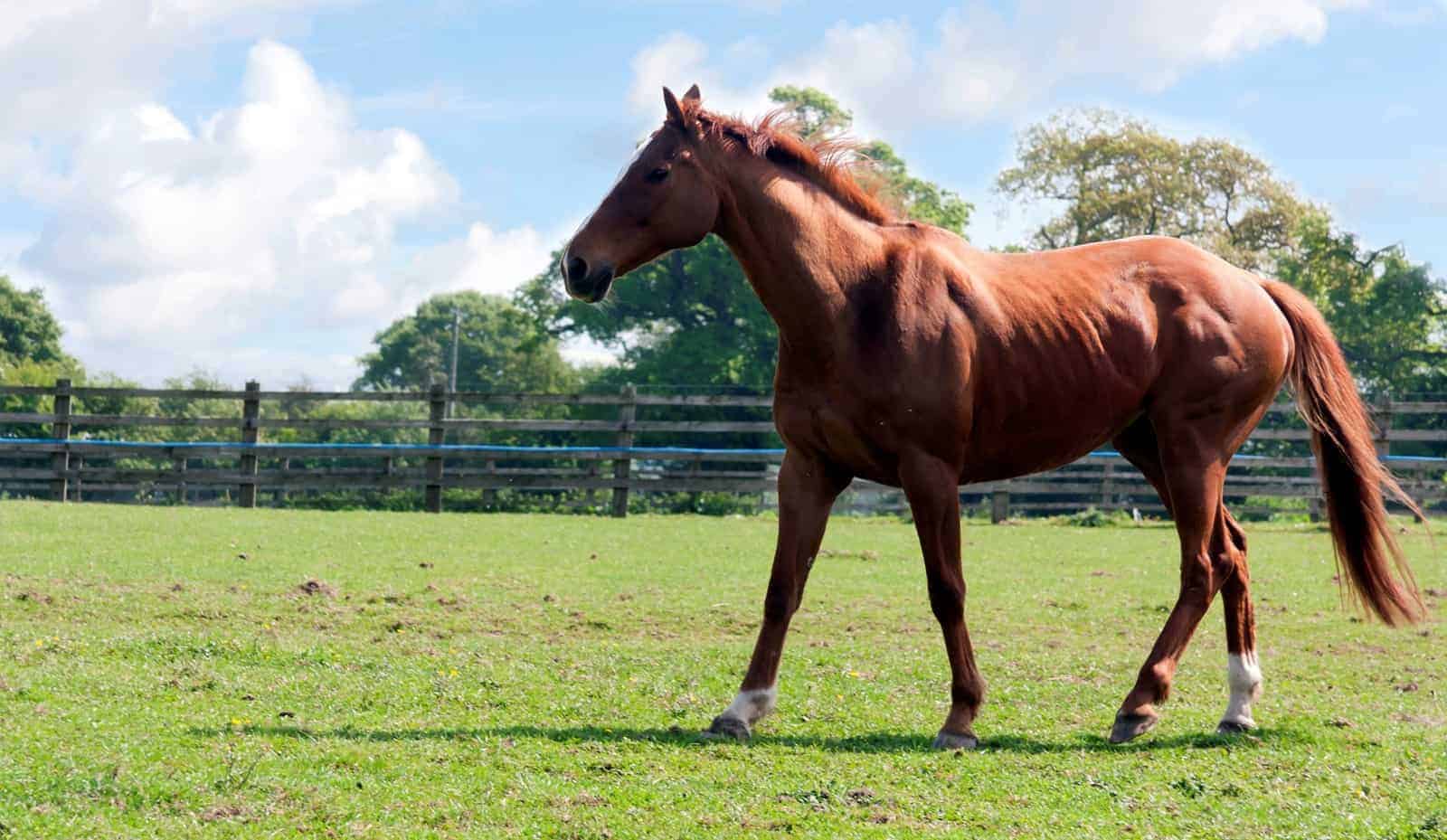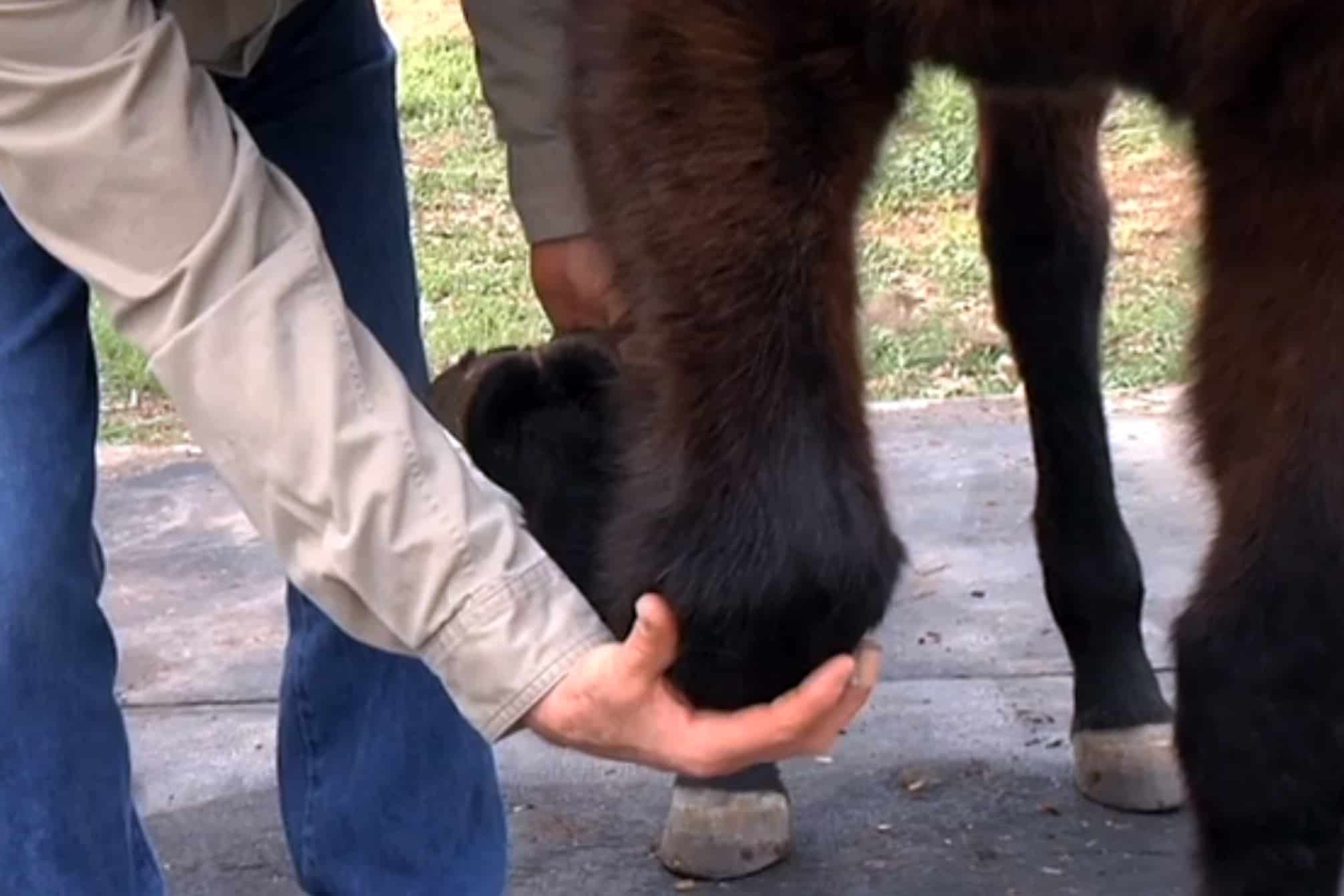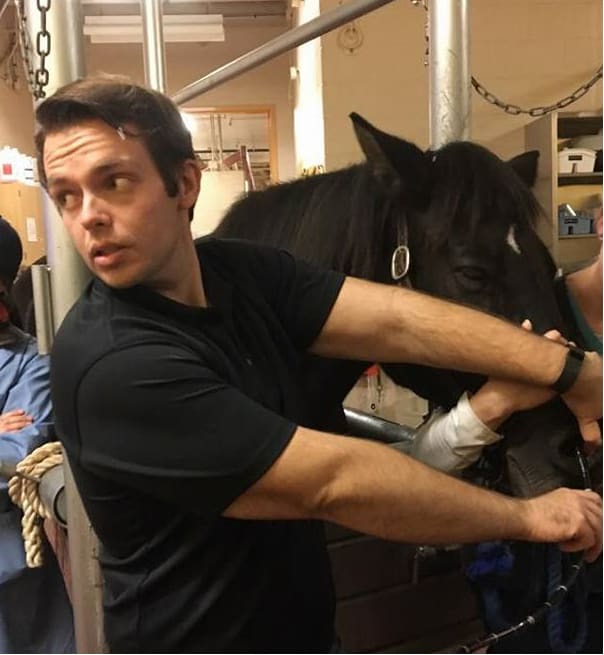Senior Horses: Handle With Care

Health and management considerations for the aging arthritic horse
If you are lucky to own a horse long enough, you’ll start to notice and understand the intricacies of aging. Your senior horse might have trouble chewing, his diet might need adjusting, and, most likely, he’ll start moving at a slower pace. Osteoarthritis (OA) can be an insidious process and a common consequence of aging. In this article we’ll describe how horses’ joints inevitably wear with age and how to keep them comfortable.
What Is Osteoarthritis?
While age is not a disease, aging predisposes horses to a number of conditions, especially OA. Formerly known as degenerative joint disease (DJD), OA can be unavoidable in geriatric equids.
Joint surfaces are covered with cartilage, which acts as a buffer to keep the joint surface happy.
“OA is characterized by chronic and progressive deterioration of cartilage between two bones called the articular surface,” says Anne Marie Skiffington, DVM, of Ocean State Equine Associates, in North Scituate, Rhode Island. “OA simply begins with any sort of destruction to the articular surface of cartilage.”
Each joint contains a finite amount of cartilage. While you can take a variety of steps to protect the cartilage, you can’t replace it. When horses experience a net loss of articular cartilage, says Skiffington, veterinarians categorize their condition as end-stage OA. This progressive condition is extremely painful and might be refractory to analgesic medications such as non-steroidal anti-inflammatory drugs (NSAIDs). Often, euthanasia is the kindest option in cases of end-stage OA.
We see two facets of OA in the equine community. It is the most common cause of performance issues in sport horses and can be detected early in life. In older horses, however, OA can be a reluctant rite of passage, a simple aging process. Furthermore, it can follow them, as Skiffington explains, from their younger years to their old age. Bony changes can develop secondary to developmental issues, high-impact performance stress, trauma, or simply decades of wear and tear.
Clinical Signs of Osteoarthritis
Mature horses can develop OA months to years prior to showing any clinical lameness. And it can start off very subtly, mostly as mild performance issues. In geriatric horses, however, the game is a little different. Elderly horses with OA have likely had it for years, and it progresses and worsens with every passing year.
“Pain, swelling of the joint, heat, pain and crepitus (crackling or grating bone) on flexion, and decreased range of motion are all commonly seen,” says Skiffington. You might also see joint deformation, particularly of the knees and fetlocks. These joints undergo such extensive bony changes that the external architecture can transform to the naked eye.
Management Tools
While we can’t cure OA, we can take steps to manage it. In sport horses, performance is often the driving force behind joint therapies. In geriatrics, however, the goal is pain management. Vets have many tools for OA management, including:
NSAIDs These drugs are a hallmark in equine medicine. Phenylbutazone (Bute), flunixin meglumine (Banamine), and firocoxib (Equioxx) are all effective tools in the OA toolbox. They work to reduce inflammation systemically and are remarkably effective at managing pain associated with OA.
“As arthritic symptoms progress, I recommend Bute the night before riding if they are happy enough on nonriding days without the Bute,” says Bibi Freer, DVM, co-owner of Hunt Country Equine Mobile Services, in Tryon, North Carolina. “As symptoms progress to the point that the horse is uncomfortable in the pasture, I may recommend 1 gram of phenylbutazone every day. This can do wonders for horses who do not have a good quality of life without it.” Firocoxib might be an effective alternative but does not have the potency of phenylbutazone.
Freer notes, however, that using NSAIDs is not consequence-free. These drugs have been associated with kidney damage, gastric ulcers, and right dorsal colitis, though firocoxib tends to have fewer systemic side effects. Bloodwork to monitor kidney values can be useful in these cases, as is gastroscopy to evaluate the stomach lining for ulcers.
Oral joint supplements I liken equine supplements to a bazaar of market vendors: You can find quality products, but they are afloat in a sea of snake oil. Equine supplements are largely unregulated, and very few companies have published research on their products. Some, however, are supported by good science, so have a discussion with your veterinarian about what oral products he or she prefers for senior equine patients.
Joint therapies Systemic joint therapies can help manage OA pain in geriatric horses. Intravenous hyaluronate sodium (Legend) has been a mainstay in equine practice, and vets administer it to performance horses with great success. Manufacturers have formulated this product to restore joint fluid to its normal state.
Polysulfated glycosaminoglycan (Adequan) has a similar effect but works in a different fashion. This intramuscular series of injections is designed to incorporate the therapy more directly into the joint. Both these products are trusted, backed by science, and considered very safe.
Joint injections Most clients associate joint injections with performance horses, as this demographic often receives them routinely to manage inflammation and pain. Joint injections can also be useful in treating pain associated with OA in geriatric horses. The difference is not where to inject, but what goes into the joint cocktail.
“I think corticosteroid injections are a good treatment in the elderly horse for certain joints,” says Freer. As the age-old backbone of joint injections, primary medications used include betamethasone, methylprednisolone, and triamcinolone. While incredibly useful for reducing inflammation associated with OA, like NSAIDs, steroids do have side effects.
“Since many older horses have pituitary pars intermedia dysfunction (PPID, aka equine Cushing’s disease), corticosteroids should be used judiciously,” Freer says. Horses with PPID are at an increased risk of developing the hoof disease laminitis, and steroid administration can throw them into a laminitic crisis.
Biologic joint therapies are quickly gaining traction, and for good reason. Products such as platelet-rich plasma (PRP), interleukin-1 receptor antagonist protein (IRAP), and autologous protein solution are becoming popular alternatives to corticosteroids. These joint therapies are processed using the horse’s own blood and then injected into the joint. While they have different mechanisms of action, biologic therapies function “to promote healing, delay the progression of joint damage, and decrease inflammation,” Skiffington says.
Furthermore, a promising synthetic option called polyacrylamide hydrogel works to mimic joint fluid and has been successful in relieving pain in joints with extensive arthritic change. These products are useful when trying to get the benefits of joint injections without the negative side effects of corticosteroids.
Farriery Considerations
You might not realize that one of the hardest things an arthritic geriatric horse must do is stand for the farrier. As a veterinarian, I have met many people who have told me, “He can’t stand, so we just don’t bother trimming him. It’s easier on him!” This is not the solution, however.

Any farrier will tell you podiatry for the geriatric horse is very different than that for a competing show jumper. “I’ve done a lot of older horses in my life that other shoers couldn’t, not because they’re not skilled shoers, but because they couldn’t hold the horse where the horse could stand,” says Bill Sugg, a farrier from Effingham, New Hampshire, who was a cowboy in his early days. “I call that shoeing the statue. You can walk up to that statue and stand under that foot and never have a problem. … There’s a lot of horses that all it takes is to pick up their foot, see where it hangs, and put your body there. And they’ll stand there all day long.”
As far as trimming cycles changing as the horse ages, Sugg says there’s no hard-and-fast rule—some horses’ hoof growth slows with age, while others’ doesn’t. He prefers to trim older horses every two to four weeks to reduce the amount of time they spend balancing on three legs. “Some people wait until there’s ¾ inch of foot to take off, and the horse’s leg is up in the air that much longer,” he says. Rather, “take a nip, rasp them off, round them out, and put their feet down. You can trim a horse like that in five to 10 minutes. I’ll do less, sooner.”
Shoes can be lifesavers for many horses with hoof conditions or needing extra support. While they might benefit the aging population, as well, their use isn’t black and white. “There are a lot of horses that shoes might help, but you’re going to do more damage to that horse trying to get them to stand long enough to get a pair on,” Sugg says. “If they can’t pick their feet up long enough to get a nail on, there is no sense.”
A large percentage of Sugg’s practice is geriatric horses, and he has more experience than most trimming and shoeing them. “Be patient,” he says. “I don’t mind petting on horses for 10 minutes while they’re trying to stand and be comfortable.” The horse will appreciate it, and chances are the client will, too. “Horses have been my livelihood my whole life so I owe them something.”
Quality of Life
Euthanasia is a sensitive topic but an unfortunate and inevitable aspect of horse ownership and equine medicine. At what point is the discussion about end-of-life decisions appropriate? Some owners cling to their rose-tinted glasses, unable to recognize their arthritic horse’s chronic pain. But that isn’t doing those animals any favors.
“From my perspective, when life isn’t fun anymore it is time to let them go,” says Freer. “The decision to euthanize a beloved companion is so personal, I tell the owner that there is no judgment from me.” When the interventions and the medications stop working, the discussion must be had.
The decision to euthanize might be clear in the midst of a thrashing, inoperable colic. But when dealing with years of chronic pain from OA, the lines become blurred. I try to have owners get a calendar and mark how many good versus bad days their horse seems to have. Holding a tangible record in their hands can make the realization an easier pill to swallow.
Euthanasia is a gift. It is the gift of letting your friend, your partner, pass peacefully on a good day rather than during a crisis situation. As a veterinarian, I am honored to play my role in the process. It is the most important thing I do—not lameness work, not vaccinations, but helping guide horses and their owners through this inevitability.
Take-Home Message
Horses age, as do their joints. Osteoarthritis is a natural, and often unavoidable, occurrence in horses of a certain age. Thankfully, veterinarians have a number of management strategies to keep your elderly companion comfortable for as long as possible.

Written by:
Chris White, DVM
Related Articles
Stay on top of the most recent Horse Health news with











